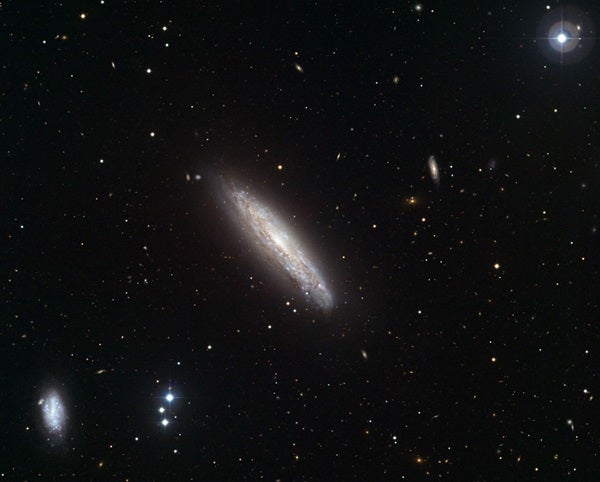The galaxy NGC 4666 takes pride of place at the center of this new image, made in visible light with the Wide Field Imager on the MPG/ESO 2.2-meter telescope at La Silla Observatory in Chile. NGC 4666 is a remarkable galaxy with very vigorous star formation and an unusual “superwind” of outflowing gas. It had previously been observed in X-rays by the ESA XMM-Newton space telescope, and this image was taken to allow further study of other objects detected in the earlier X-ray observations.
The prominent galaxy NGC 4666 in the center of the picture is a starburst galaxy, about 80 million light-years from Earth, in which particularly intense star formation is taking place. The starburst is thought to be caused by gravitational interactions between NGC 4666 and its neighboring galaxies, including NGC 4668, visible to the lower left. These interactions often spark vigorous star formation in the galaxies involved.
A combination of supernova explosions and strong winds from massive stars in the starburst region drives a vast flow of gas from the galaxy into space — a so-called “superwind.” The superwind is huge in scale, coming from the bright central region of the galaxy and extending for tens of thousands of light-years. As the superwind gas is very hot, it emits radiation mostly as X-rays and in the radio part of the spectrum and cannot be seen in visible light images such as the one presented here.
This image was made as part of a follow-up to observations made with the ESA XMM-Newton space telescope in X-rays. NGC 4666 was the target of the original XMM-Newton observations, but, thanks to the telescope’s wide field of view, many other X-ray sources were also seen in the background. One such serendipitous detection is a faint galaxy cluster seen close to the bottom edge of the image, right of center. This cluster is much farther away from us than NGC 4666, at a distance of about 3 billion light-years.










